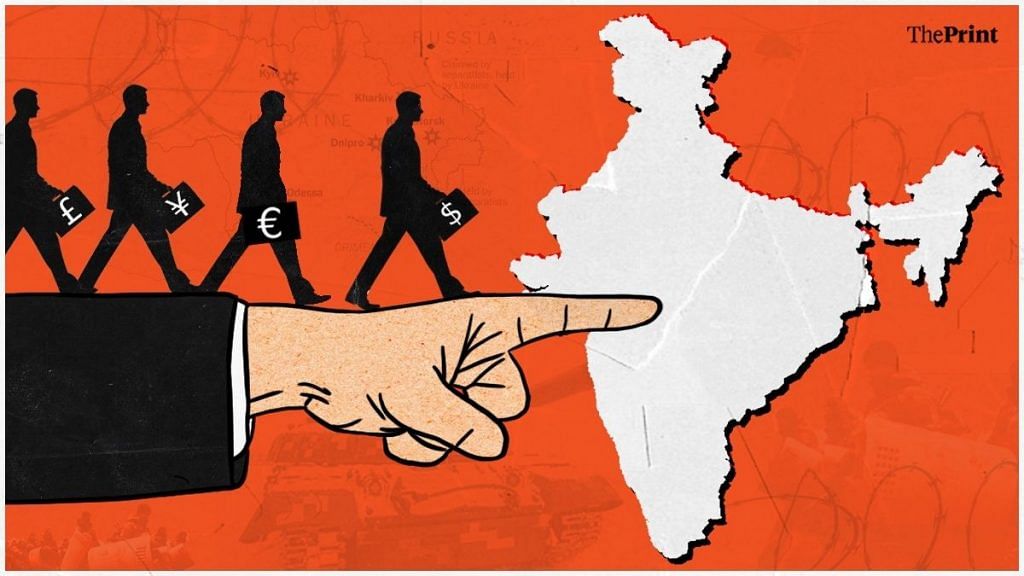The Russia-Ukraine war has led to greater uncertainty in the world and could possibly increase home bias among developed-country investors. More capital is likely to be invested in the US and Europe rather than in third world countries.
However, of the capital that does get invested abroad — both in terms of FII (foreign institutional investment) and FDI (foreign direct investment) — after the war, India could become a more attractive investment destination due to its democracy, foreign policy, internal stability, steps towards reducing the cost of doing business, and commitment to cutting carbon emissions.
In the immediate context, it may be argued that a war creates a ‘risk-off situation’ and in the short run, foreign portfolio investors will leave emerging markets and go back to safe haven assets such as the US dollar. Institutional investors have been seen to leave India even before the war due to the US Fed’s tightening of monetary policy. The possibility of US sanctions on India due to its dealings with Russia and Iran create a further risk.
At the same time, with higher uncertainty and greater global macroeconomic instability due to the rise in commodity prices, the economic sanctions on Russia and the continuing tension, there is a strong likelihood of investors waiting for the situation to improve before committing investments.
Once the war is over, among other factors, India can be seen as a more attractive investment destination as it is a democracy. In addition, India is geo-strategically placed to be a counterbalance to China in this region. India is working towards improving the environment for investors, and further reforms will help make it more attractive.
Robust foreign direct investments
FDI inflows into India have been robust over the past few years. According to estimates by the Ministry of Commerce and Industry, FDI inflows in the past seven years (2014-2021) stood at $440.27 billion, which is nearly 58 per cent of the total FDI inflows in the past 21 years. Policymakers have taken a number of steps to boost foreign investment, such as reducing the corporate tax rate, reducing the compliance burden, and a commitment to infrastructure development through the National Infrastructure Pipeline.
Also read: How should RBI tackle inflation? Give clear signal, revisit projections, adjust policy stance
Fund diversion from China
In the aftermath of the Evergrande crisis — an ongoing financial crisis sparked by the difficulties of real estate developer Evergrande — and consequent slowdown in China, India provides an attractive alternative investment destination with a more stable political and regulatory landscape.
China has recently passed legislation laying down tougher rules for how companies handle user data. The regulatory clampdown on technology companies such as Alibaba Group Holdings Limited and Tencent Holdings Limited has dimmed China’s appeal as the preferred investment destination. Technology-focussed global venture capital investors have increased their exposure to India. A recent research report suggests that India has jumped to the third spot in terms of global technology venture capital investments in 2021.
Policies to liberalise FII investments
Several steps have been taken to provide greater access for foreign investors into government securities. The latest move is the Fully Accessible Route (FAR) under which, for certain notified securities, there are no limits on foreign investments. Going forward, all securities will be open to foreign investments without any limit. These initiatives could be seen as a precursor to Indian bond inclusion in global bond indices. While the recent budget did not make an announcement on this, the government seems to be sorting out issues relating to the inclusion of the country’s bonds in global bond indices.
Also read: Indian economy was recovering after Omicron but Russia-Ukraine crisis can spoil the party
Booming exports
Despite disruptions caused by the Covid-19 pandemic, India’s merchandise exports for the first time crossed the $400-billion mark by 21 March, 2022. They had risen by 37 per cent to $400.8 billion in 2021-22 until 21 March from $292 billion in 2020-21.
Exports have also become more diversified to include engineering goods, apparel, garment exports etc. Booming and diversified export potential will provide an impetus to domestic and foreign investments in India.
Commitment to reducing carbon emissions
Prime Minister Narendra Modi presented a five-point strategy to deal with climate change challenges at the COP26 summit in Glasgow in November last year. Ambitious targets outline India’s commitment to climate change and will also open massive investment opportunities across sectors such as renewables, electric vehicles, green hydrogen etc.
India plans to manufacture five million tonnes of green hydrogen per annum by 2030, in an effort to meet its climate goals and become a production and export hub for the environment-friendly fuel.
The issuance of sovereign green bonds as part of the total market borrowings is a component of India’s strategy to reduce carbon emissions. These will be rupee-denominated bonds with a long tenure to suit the requirements of green infrastructure projects. The proceeds will be deployed in projects that will help in reducing the carbon emissions.
A sovereign green bond issuance is likely to garner interest from global investors who have a large pool of capital and are looking for greener investments. Even before any issuance has been announced, a number of Canadian pension funds are placing bets on India and investing in clean energy projects.
The opportunity created by the current global situation could turn to India’s favour. It is incumbent upon policymakers in India to seize this opportunity.
Ila Patnaik is an economist and a professor at National Institute of Public Finance and Policy.
Radhika Pandey is a consultant at NIPFP.
Views are personal.
Also read: Cut taxes & simplify them. That’s the best option for Budget to spur demand, boost recovery
